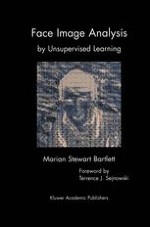2001 | OriginalPaper | Buchkapitel
Introduction
verfasst von : Marian Stewart Bartlett
Erschienen in: Face Image Analysis by Unsupervised Learning
Verlag: Springer US
Enthalten in: Professional Book Archive
Aktivieren Sie unsere intelligente Suche, um passende Fachinhalte oder Patente zu finden.
Wählen Sie Textabschnitte aus um mit Künstlicher Intelligenz passenden Patente zu finden. powered by
Markieren Sie Textabschnitte, um KI-gestützt weitere passende Inhalte zu finden. powered by
How can a perceptual system learn to recognize properties of its environment without being told which features it should analyze, or whether its decisions are correct? When there is no external teaching signal to be matched, some other goal is required to force a perceptual system to extract underlying structure. Unsupervised learning is related to Gibson’s concept of discovering “affordances” in the environment (Gibson, 1986). Structure and information are afforded by the external stimulus, and it is the task of the perceptual system to discover this structure. The perceptual system must learn about the underlying physical causes of observed images. One approach to self-organization is to build generative models that are likely to have produced the observed data. The parameters of these generative models are adjusted to optimize the likelihood of the data within constraints such as basic assumptions about the model architecture. A second class of objectives is related to information preservation and redundancy reduction. These approaches are reviewed here. The two approaches to unsupervised learning are not mutually exclusive, and it is often possible, as will be seen below, to ascribe a generative architecture to an information preservation objective, and to build generative models with objectives of information preservation. See (Becker and Plumbley, 1996) for a thorough discussion of unsupervised learning. Hinton and Sejnowski’s Unsupervised Learning: Foundations of Neural Computation (Hinton and Sejnowski, 1999) contains an anthology of many of the works reviewed in this chapter. A recommended background text is Dana Ballard’s Introduction to Natural Computation (Ballard, 1997).
